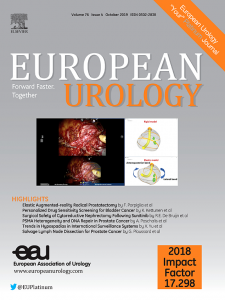European Association of Urology Guidelines on Male Sexual and Reproductive Health: 2025 Update on Male Infertility
IF 25.3
1区 医学
Q1 UROLOGY & NEPHROLOGY
引用次数: 0
Abstract
Background and objective
To present a summary of the updated 2025 European Association of Urology (EAU) Guidelines on Sexual and Reproductive Health (SRH) on male infertility, providing practical recommendations on the clinical work-up with a focus on diagnosis, treatment and follow-up.
Methods
For the 2025 SRH guidelines, new and relevant evidence was identified, collated, and appraised via a structured assessment of the literature. Databases searched included Medline, EMBASE, and the Cochrane Libraries. Recommendations within the guidelines were developed by the panel to prioritise clinically important care decisions. The strength of each recommendation was determined according to a balance between desirable and undesirable consequences of alternative management strategies, the quality of the evidence (including the certainty of estimates), and the nature and variability of patient values and preferences.
Key findings and limitations
Key recommendations emphasise the importance of a thorough urological assessment of all men seeking medical help for fertility problems to ensure appropriate treatment. The guidelines also stress the clinical relevance of a parallel investigation of the female partner during the diagnostic and management work-up of the infertile couple, to promote shared-decision making in terms of timing and therapeutic strategies. Furthermore, the guidelines recommend to counsel all infertile men and men with abnormal semen parameters on the associated health risks. Key changes in the male infertility guidelines for 2025 include: the addition of two new sections addressing exome sequencing and probiotic treatment; and significant update of the evidence base and recommendations for the diagnostic work-up of male infertility.
Conclusions and clinical implications
This overview of the 2025 SHR guidelines offers valuable insights into the diagnosis, classification, treatment and follow-up of male factor infertility and are designed for effective integration into clinical practice.
欧洲泌尿外科协会男性性健康和生殖健康指南:2025年男性不育症更新
背景和目的介绍最新的2025年欧洲泌尿外科协会(EAU)关于男性不育症的性健康和生殖健康(SRH)指南的摘要,提供关于临床检查的实用建议,重点是诊断、治疗和随访。方法对于2025年的SRH指南,通过对文献的结构化评估来识别、整理和评价新的相关证据。检索的数据库包括Medline、EMBASE和Cochrane图书馆。指导方针中的建议是由专家组制定的,以优先考虑临床重要的护理决定。每个建议的强度是根据备选管理策略的理想和不希望的结果之间的平衡来确定的,证据的质量(包括估计的确定性),以及患者价值和偏好的性质和可变性。主要发现和局限性主要建议强调了对所有因生育问题寻求医疗帮助的男性进行全面泌尿学评估以确保适当治疗的重要性。该指南还强调在不孕夫妇的诊断和管理检查期间对女性伴侣进行平行调查的临床意义,以促进在时机和治疗策略方面的共同决策。此外,指南建议就相关的健康风险向所有不育男性和精液参数异常的男性提供咨询。2025年男性不育症指南的主要变化包括:增加了两个新的章节,涉及外显子组测序和益生菌治疗;并对男性不育症诊断检查的证据基础和建议进行了重大更新。结论和临床意义2025年SHR指南概述为男性因素性不育症的诊断、分类、治疗和随访提供了有价值的见解,旨在有效地融入临床实践。
本文章由计算机程序翻译,如有差异,请以英文原文为准。
求助全文
约1分钟内获得全文
求助全文
来源期刊

European urology
医学-泌尿学与肾脏学
CiteScore
43.00
自引率
2.60%
发文量
1753
审稿时长
23 days
期刊介绍:
European Urology is a peer-reviewed journal that publishes original articles and reviews on a broad spectrum of urological issues. Covering topics such as oncology, impotence, infertility, pediatrics, lithiasis and endourology, the journal also highlights recent advances in techniques, instrumentation, surgery, and pediatric urology. This comprehensive approach provides readers with an in-depth guide to international developments in urology.
 求助内容:
求助内容: 应助结果提醒方式:
应助结果提醒方式:


